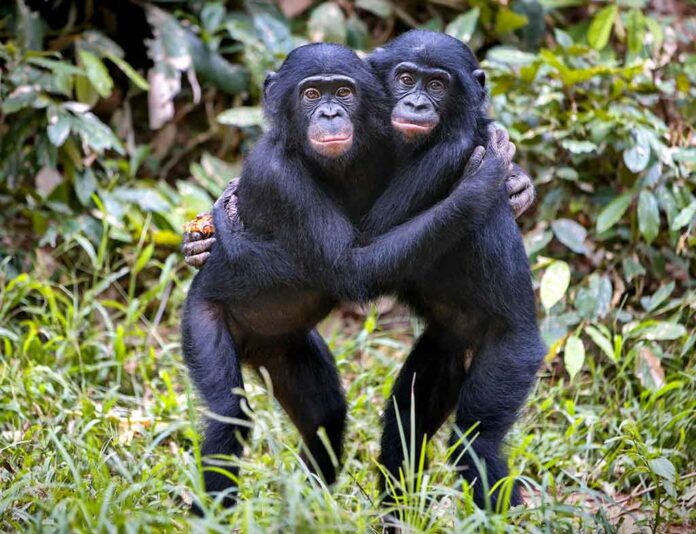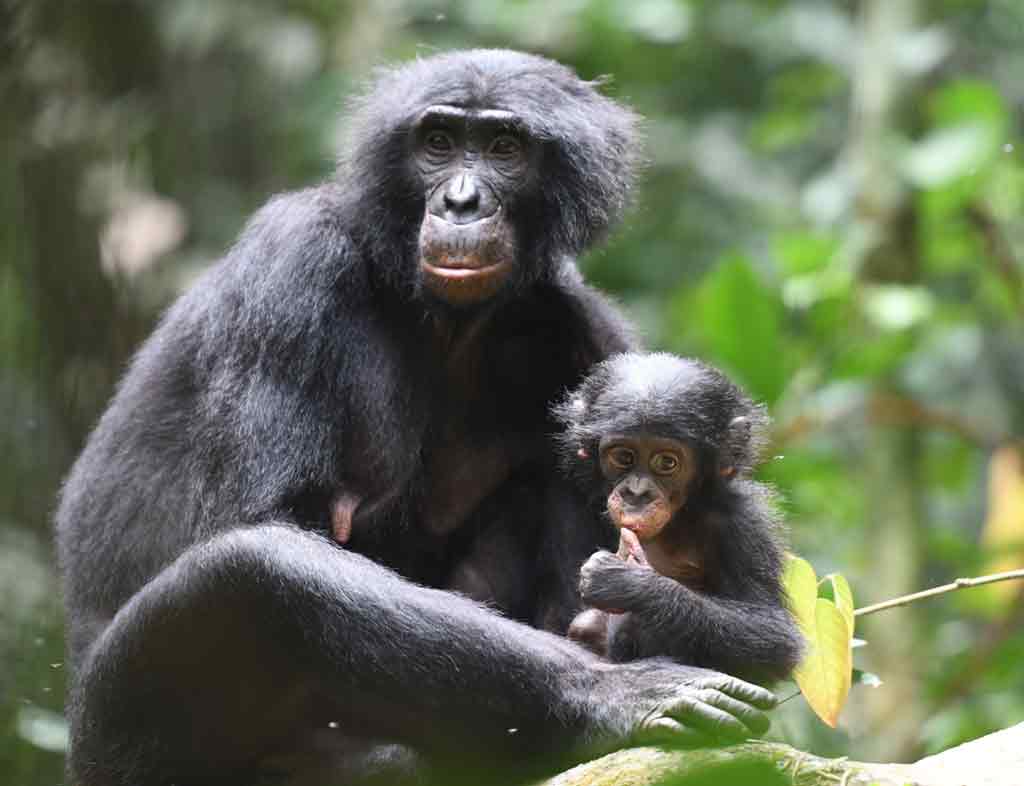
Bonobo, The Peaceful Primates, often referred to as the “hippies of the primate world,” are fascinating creatures that share over 98% of their DNA with humans. In this article, we delve into the world of bonobos, exploring their physical characteristics, behaviour, conservation status, and more.
Bonobos (Pan paniscus) is one of the two species of chimpanzees, along with the common chimpanzee (Pan troglodytes). They are closely related to humans and share many behavioural and physiological traits. Bonobos are native to the dense rainforests of the Democratic Republic of Congo in Central Africa.
Table of Contents
Physical Characteristics
Bonobo, The Peaceful Primates are smaller and more gracile than common chimpanzees, with a leaner build and longer limbs. They have black fur covering their bodies, with pink lips and faces. One of the most distinctive features of bonobos is their long, slender arms, which they use for climbing and swinging through the trees.
Habitat and Distribution
Bonobos are found exclusively in the rainforests of the Democratic Republic of Congo, where they inhabit dense, swampy forests near rivers and streams. They are primarily arboreal, spending much of their time in the canopy, but they also come down to the forest floor to forage for food.
Social Structure and Behaviour
Bonobo, The Peaceful Primates live in large, complex social groups known as communities, which can consist of anywhere from 20 to 100 individuals. Unlike common chimpanzees, which have a male-dominated social hierarchy, bonobos exhibit a more egalitarian social structure, with females often holding higher status than males.
Diet and Feeding Habits
Bonobos are omnivores with a predominantly frugivorous diet, meaning they mainly eat fruit. However, they also consume a variety of other foods, including leaves, flowers, seeds, insects, and occasionally small mammals. Bonobos are known for their sophisticated feeding behaviours, using tools such as sticks and leaves to extract food from hard-to-reach places.
Reproduction and Life Cycle
Female bonobos typically give birth to a single offspring every 4 to 6 years, with a gestation period of around 8 months. Infant bonobos are dependent on their mothers for several years and receive care and protection from other members of the community. Bonobos reach sexual maturity at around 8 to 10 years of age.
Conservation Status
Bonobos are listed as endangered by the International Union for Conservation of Nature (IUCN) due to habitat loss, poaching, and human encroachment. It is estimated that fewer than 20,000 bonobos are remaining in the wild, and their population is declining rapidly.
Threats to Bonobo, The Peaceful Primates
The primary threats to bonobos include deforestation, habitat fragmentation, hunting for bushmeat, and the illegal pet trade. Additionally, political instability and armed conflict in the Democratic Republic of Congo have further exacerbated the challenges facing bonobo conservation.
Conservation Efforts
Efforts to conserve bonobos include the establishment of protected areas, community-based conservation initiatives, anti-poaching patrols, and research and education programs aimed at raising awareness about the plight of bonobos and their importance to the ecosystem.
Human-Bonobo Conflict
Human-bonobo conflict occurs when bonobos come into contact with human populations, leading to conflicts over resources such as food and territory. Efforts to mitigate human-bonobo conflict include community outreach programs, sustainable livelihood initiatives, and the development of alternative sources of income for local communities.
Cultural Significance
Bonobos hold significant cultural and symbolic value in the Democratic Republic of Congo, where they are revered as sacred animals by some indigenous cultures. They feature prominently in local folklore, art, and traditional medicine practices.
Bonobo Tourism
Bonobo tourism, including ecotourism and wildlife viewing, has the potential to generate revenue for local communities while promoting conservation efforts and raising awareness about the importance of protecting bonobos and their habitat.
Wildlife Ecology in United States
Bonobo, The Peaceful Primates

FAQs
1. Are bonobos endangered?
Yes, bonobos are classified as endangered by the IUCN due to habitat loss and hunting.
2. Do bonobos live in groups?
Yes, bonobos live in large social groups known as communities, which are led by a dominant female.
3. What do bonobos eat?
Bonobos are primarily frugivorous, but they also consume leaves, flowers, seeds, and insects.
4. Can bonobos communicate with humans?
Bonobos have been taught to communicate with humans using sign language and other methods, demonstrating their intelligence and cognitive abilities.
5. How can I help protect bonobos?
You can help protect bonobos by supporting conservation organizations, spreading awareness about their conservation status, and avoiding products made from bonobo parts.








